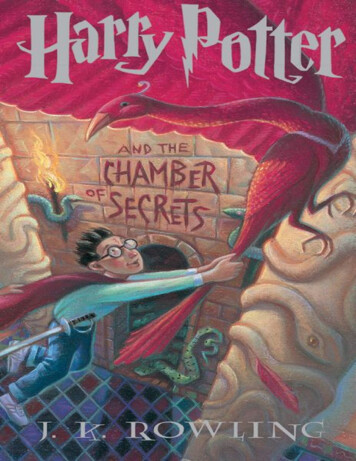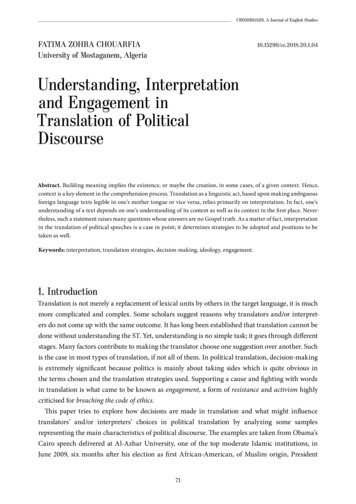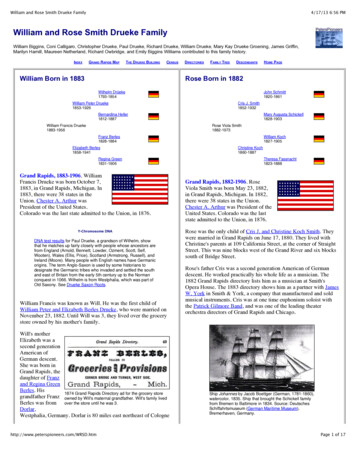
Transcription
Research & ScholarshipAn ideological reading of UncleArthur’s bedtime stories usingcritical literacyTEACHRRhys NichollsEnglish Teacher, St Peters Anglican College, Broulee, NSWDaniel ReynaudAssociate Professor, Dean of the Faculty of Arts, Avondale College, NSWAbstractUncle Arthur’s bedtime stories stands as theprincipal and archetypal Seventh-day Adventistchildren’s literature text. It is heavily inscribedwith distinct ideologies, which are specificallyreferential to Seventh-day Adventist dogmaand faith. As children read these texts, they areexposed to, and affected by, these ideologies.This thesis seeks to expose the overt and covertideologies of the text so that their power canbe recognised and their value evaluated. Thisis accomplished through a brief investigationof the author and the publishing institution thatconceived the texts, then through an explanationof the development and aims of critical literacyreading processes. These reading processes arethen applied to the text in order to render explicitthe belief structures constructed into the textwhich sustain the stories’ proposed ‘truths’ and‘meanings’.This investigation has revealed that UncleArthur’s bedtime stories assumes levels ofauthority over truth, interpretation and thereader, which it does not intrinsically command.This assumption of authority allows the text topropose and defend one-sided ‘truths’, spuriousarguments and potentially unethical behaviour.IntroductionUncle Arthur’s bedtime stories were written inan era of fragility and upheaval in the post-warperiod of the 1920s. For the Seventh-day AdventistChurch, however, it was a time of significant growth,especially through the Church’s publishing arm.Arthur S. Maxwell made a substantial contributionto the church’s mission through his literature, themost widely circulated of which was Uncle Arthur’sbedtime stories.Uncle Arthur’s bedtime stories are arguably themost popular and influential Seventh-day Adventistchildren’s literature ever distributed. First publishedas a ten volume set in 1928, the books achieved atotal circulation of over forty million books in twentyone languages by 1982 (Jean, 1983; Neufeld, 1996;Schwartz, 1983). Part of the reason for this broadappeal comes from the texts’ ability to traversedenominational lines; the books have been endorsedand advertised by people of varying faiths andin prominent leadership positions (Jean, 1983;Schwartz, 1983).Designed and written as character-buildingchildren’s storybooks, the texts aim “to lead boysand girls to choose the good way of life; to help themto be kind, honest, truthful, and obedient, and aboveall to love God with all their hearts” (vol 1, p. 12).The highly moralistic stories are presented as “trueto life about things that actually happened to realboys and girls” (vol. 2, pp. 10–11). The texts servedthe purposes of both reflecting the ideologies oftheir time, while also informing and shaping thesesame worldviews for the future. Maxwell attributedhis worldview to his own near-death experience and“thereafter believed God had preserved him for aspecial purpose” (Jean, 1983, 24; Neufeld, 1996).This worldview of God’s direct intervention in humanexperiences formed an intrinsic and foundationaltheme which ran through many of his children’sstories (Jean, 1983).“The textsserved thepurposesof bothreflecting theideologiesof their time,while alsoinformingand shapingthese sameworldviewsfor the future”A problem: Evidence of damaging social andreligious effects of Uncle Arthur’s bedtimestoriesDespite the laudable aims of Uncle Arthur’sbedtime stories, the response of some readersraises questions. Testimonial evidence comparesthe stories with the experiences of the reader.Berecz (1996, pp. 10, 12) questions the universalvalidity of ‘Uncle Arthur’s’ “interventionist God”, who“dispatches guardian angels to keep approachingdrunk drivers from swerving over the yellow linev4 n1 TEACH 47
Research & ationship,‘truth’, andintentionconcernsand snuffing out life”. He argues that the “threemajor problems with such deliverance stories [are]probabilities, selective sampling, and linear theoriesof causality.” McNiely (1996, p. 64) recounts theconfusion she felt as a direct result of the tensionbetween her lived experiences and her engagementwith Uncle Arthur’s bedtime stories. Having grown upwith the texts in the mission field, she states that atragedy that befell fellow missionaries “was a shockto me I was never the same again”. The problemcreated by Bedtime stories was so significant thatshe began writing her own stories that attemptedto rectify the imbalance of ‘Uncle Arthur’s’, “vividscenarios of divine intervention” (Berecz, 1996).The second category is the alignment of UncleArthur’s bedtime stories with distorted social andreligious ideologies. The website, whitefuture.com, a propaganda text for a white supremacistorganisation contains an article in which the authorsystematically and effectively deconstructs picturesfrom Uncle Arthur’s bedtime stories to endorse,apart from their “rock solid call to honesty, andother noble character attributes”, the admirablelack of “non-white faces jumping up here and there,and everywhere, trying to invade the pleasantand relatively safe environment of White society”.While obviously an extreme reading, it requires nodistortion of the texts and reveals a dynamic thatexists within Uncle Arthur’s bedtime stories.That a Seventh-day Adventist children’sstorybook series can be effectively utilised to defendworldviews as destructive and offensive as thesewarrants a detailed and critical investigation of thesocial concerns of Uncle Arthur’s bedtime stories. Inaddition, a study that indicates the extent, if any, ofconfusion arising for children (especially those fromwithin Adventist culture) out of the belief systemsregarding God’s intervention in the world wouldlikewise be valuable.”Critical literacy and Uncle Arthur’s bedtimestoriesLiterary theory and critical theory recognises thata reader’s response to a text is shaped by a varietyof perspectives and experiences such as race,gender, class and / or religion (Athanases, 1998;Fish, 1995; Harris, 1999; Morrison, 1992; SpearsBunton, 1990). The resistant reading and decodingof texts allowed by postmodernism, coupled withcritical theory’s emphasis on the liberation of the‘causalities’ of scientific and capitalist ‘progress’brings us to the purpose of critical literacy process.At its most idealistic, critical theory process is areading approach concerned with making explicitthe ideological workings of texts in order to negatethe power of the belief systems which constructed48 TEACH v4 n1them (Boutte, 2002; Christie & Misson, 1998;Langford, 2001). Through the negation of thesepower structures, readers are able to negotiate andcall into question the ‘truth’ assumptions of texts,and to interpret the texts’ significance and meaningin the light of their own personal experiences.Further, as, “reading is an act of coming to know theworld (as well as the word) and a means to socialtransformation”, it is hoped that critical literacyprocesses enable the “alleviation of human sufferingand the formation of a more just world through thecritique of existing social and political problems andthe posing of alternatives” (Cervetti, et al., 2001,p. 5).Pertinent to this study are a number of criticalliteracy questions adapted from Johnson (1999),which deal with issues of literature, culture, andpower relationships and assumptions. Thesequestions include author-reader relationship, ‘truth’,and intention concerns. The ‘author function’ ismerely as an arbitrarily controlling and limitingobstruction to reading and understanding, but itis all the more serious in the case of children’sliterature because children’s texts “serve as a formof education and socialisation that conveys society’sdeepest hopes, fears, expectations, and demands”(Boutte, 2002). Boutte notes that where the powerrelationship between the author and the reader ismore pronounced, the conveyance of the author’sideologies is likewise. The purpose of applying acritical literacy process is primarily to establish howthe constructed author-reader relationship relates tothe possible relinquishment of the reader’s authorityover truth to the author. Where there is an apparently‘natural’ power relationship of author over reader, theauthor’s ideologies become more compelling.The ‘truth’ concerns of the chosen text refer tothe metanarratives that constitute the structure onwhich meanings are transmitted through the text.These universalising truth claims, while perhapsexplaining one aspect of the human condition andthe world, invariably “impose restrictive boundarieson an otherwise pluralist, diverse cultural formation”(Webster, 1996, p. 125). To this end, a number ofcritical questions and ideas are relevant. Firstly,the truth claims which run consistently throughthe text need to be identified and made explicit. Ina referential step backwards, it then needs to beasked, from what authoritative platform or ‘pulpit’are these truth claims made and to what ideologicalcontext do the metanarrratives refer? Additionally,to what extent are the truth claims made to appearnatural, given and irrefutable? Does the text includefundamental ambiguities which allow for discussionof, and resistance to, the proposed truth claims?Also required is a critical re-evaluation of the
Research & Scholarshipnotion that to know the intention of a work is to knowthe intrinsic truths that the work holds (Webster,1996). For a text such as Uncle Arthur’s bedtimestories, which explicitly and proudly professes itsintentions from the very beginning, it is necessaryto examine how the text works to realise theseintentions, and how, in adopting its strategies, andthe language used as a part of these strategies,the text holds other deeper-seated reasons for itscreation and distribution (Boutte, 2002; Webster,1996).By applying critical literacy questions to UncleArthur’s bedtime stories, it becomes possible toachieve some of its ‘grand’ aspirations, freeing thereader from institutional rhetoric which underminesthe “train[ing of] the youth to be thinkers, and notmere reflectors of other men’s thoughts” (White,1952, p. 17).Ideology: Author-reader concernsArthur S. Maxwell—or more specifically, ‘UncleArthur’—assumes a significant God-like presence inthe texts. The pseudonym ‘Uncle Arthur’ ‘naturally’confers the benefits of a trustworthy, wise andfamilial uncle to Maxwell. He has thus essentiallybreached a substantial interpersonal divide betweenhimself and his audience, which might otherwiseallow children to read his books from a moredetached and sceptical perspective.The presence of patriarchally authoritative ‘UncleArthur’ permeates the texts from cover to cover,despite Maxwell openly soliciting for submissionsof experiences from his readers. Yet Maxwell alsoalludes to the subjectivity of the process of writingthe stories. His own children were his original muse,providing “the ideas and the inspiration for so manystories”. This recognition of the strong subjectivenature of his stories runs in sharp contrast to hisrepeated assurances to parents and children that“every story is founded on fact” (Vol.3, p. 12–13),because factuality is based on objective observationrather than subjective interpretation. This assuranceis especially questionable in light of the realisationthat by the time these ‘facts’ are communicated tothe child, they have been filtered and interpretedby at least two mediums, namely, the adult or childwho wrote the story to Maxwell, and then Maxwellhimself, as he recreated the letter into a readableand entertaining story for young children.Through this confusion over the actual level ofobjectivity in the Bedtime stories, Maxwell addsanother layer to the image of his authority andreliability. By blurring the lines between fact andfiction, Maxwell is able to attach a level of legitimacyand accuracy to his stories that doesn’t actuallyexist. He claims that his stories are “true” (vol. 4,p. 13) and “true to life” (vol. 1, p. 12) because of thefactualness of the accounts. However, he ignores,and by implication, encourages the reader to ignore,his own process of selection and rejection that mustinevitably take place as he constructs the stories.What he proposes then as an objective reflection oflife, and of the way the world operates and humansbehave, through his conception of a genre thatcan be accurately described as children’s “classicrealism” (Webster, 1996, 54), becomes merely hisown selective and ideologically motivated take onreality. What would happen, it can be posed, if hewas sent a story that described the failure of God tointervene? Would ‘Uncle Arthur’ include this story inthe collection? If he didn’t, then by his own definition,he is no longer being true to life. At a more ‘ordinary’and everyday level, if a child sent a letter thatdescribed the experience of divorce would Maxwellinclude it? Certainly, a scan of the stories in thevolumes suggests not, because it quickly becomesobvious that his stories largely ignore pain ratherthan exhibiting a “radical sensitivity to suffering”, thelikes of which is demonstrated throughout, and whichgives further legitimacy to the Biblical narrative andtexts (Middleton & Walsh, 1995, p. 143).“Ideology: Intention concernsOne possible explanation for the lack diversity ofexperience in Maxwell’s stories is that a significantpart of the thematic editing process probablyoccurred at the point of submission. Having engagedwith his texts, those submitting experiences wouldhave perceived that any stories outside of the genreto which he adheres would not be considered forpublication.That Maxwell engages in a process ofconscious selection and rejection of stories andexperiences is demonstrated in, Those prayers ofyours (vol. 1, p. 39–42). This narrative consists ofa highly rhetorical exposition of Maxwell’s beliefin an interventionist God. Maxwell’s theology ofthe nature and workings of God in the world areessentially encapsulated in this four-page statement,which proposes that “Jesus cares and that Jesusintervenes” (Berecz, 1996, p. 10). Without exploringthe validity of this theology, a critical examinationof the reasoning Uncle Arthur employs reveals notonly the highly subjective and problematic evidencehe uses to support his claims, but also his lack ofdiscretion in presenting that evidence to young andimpressionable minds so as to maintain a highlylimiting and exclusive worldview.He begins the segment by posing a question,which he then immediately and authoritativelyanswers, “Does Jesus really answer children’sprayers? Of course He does” (p. 39). No sooner hasBy blurringthe linesbetween factand fiction,Maxwellis able toattach a levelof legitimacyandaccuracy tohis storiesthat doesn’tactually exist”v4 n1 TEACH 49
Research & Scholarship“‘UncleArthur’ isrepresentedas similarto Christand therebygains theunimpeachable and incontestableauthority ofJesushe answered his own rhetorical question, than hedemands that the young reader not “ever let anybodytry to persuade you that He doesn’t”. Having setthe tone for the piece in such a way as to disallowany voice that might disagree on any grounds,Maxwell then presents his case for his unequivocallyaffirmative ideology. He explains that he has cometo his conclusion because he has “had so manychildren tell [him] that they have had their prayersanswered, [that] they couldn’t all be mistaken,could they?” (p. 39). Again, the reader knows thequestion is rhetorical because of the unambiguouscontext in which it is asked. It is not a question ofinquiry or uncertainty, as in ‘Could they possibly bewrong?’ but rather it is an unquestionable affirmationthat Maxwell has come to the correct conclusion.However, the fallaciousness of his argumentbecomes evident in the light of the conspicuous andintentional omission of what is obviously the nextlogical question to ask in order to receive a balancedresponse, How many children have asked Jesusfor something really definite, and have not beenanswered at all?Another layer is added again to the authoritativepatriarchal voice through the inclusion of a prefaceand lesson index at the beginning of each volume.The lesson index consists of two pages of headingssuch as “Cooperation”, “Grumbling, Cure for”, and“Temptation, Help in”, with ‘relevant’ stories listedunder each heading. The explicit function of theseprefaces is to communicate a number of facts aboutthe texts, which Maxwell feels are important for thereader to know. These facts include such things asthe intended purposes of the texts and the high levelof consistency maintained in the stories. The explicitand obvious function of the lesson index is to “makethe purpose [of each story] plain” (vol. 3, p. 13). Froma critical perspective, the implicit function of theseprefaces and indexes is to ‘prime’ the reader for thetext, so that it is read in a prescribed and limitingmanner. This perspective is bolstered by the factthat all but one of the prefaces direct the reader tomove from the preface to the index and then to thetext itself, in order to ensure that the text is read inthe manner the author desires it to be read. Even theact of reading thus occurs under the direction andsupervision of the author and the institution whichpublished the texts.In addition to the authority assumed over themeaning of the stories and the reading approachesto the texts, ‘Uncle Arthur’ is represented as similarto Christ and thereby gains the unimpeachable andincontestable authority of Jesus. Maxwell unsubtlyplaces his claim to his connection with childrenimmediately after pointing out the nature of Jesus’relationship with children: “[Jesus] is the greatest”50 TEACH v4 n1lover of little children I love children very much.”The use of the key words “love” and “children” inquick succession work to bring the figure of Christand that of ‘Uncle Arthur’ in closer relation with eachother.The use of language to position Maxwell inJesus’ place extends beyond mere similarity andproximity. The manner in which the passage isconstructed also leads to a pronounced link beingmade between the two figures. This can be seenwhere the focus of the discourse shifts from theidentification of Jesus by name, to the replacementof his name with the personal pronoun “He”, thento the person of Maxwell, represented by thepersonal pronoun “I”. What in fact occurs throughthis transition is the blurring of the image of Jesusinto the unnamed, and therefore to some extentunidentified “He”, and then onto the similarlysomewhat vague identification of ‘Uncle Arthur’in “I”. The effect of this language choice is todisseminate the identity of Christ from one directionand reconstruct this identity into ‘Uncle Arthur’ fromthe other.This example of ‘Uncle Arthur’s’ assimilationinto the image of Jesus does not stand alone inthe texts. Another two examples occur in pictorialrepresentations that similarly juxtapose the figureof Christ with the figure of ‘Uncle Arthur’. The first(Vol 1, p. 2) is where the reader is presented with aheavily constructed image of ‘Uncle Arthur’ sittingin an armchair, engaged in telling stories to threegirls and two boys who sit either on his knees orattentively on the floor in front of him. In the picture,Maxwell occupies the central position of the page.His body language towards the children is intimateand affectionate, as theirs is to him. In the samevolume (p. 322) is another image, which bears anuncanny resemblance to the one just mentioned,however, in this instance, the central spacepreviously occupied by Uncle Arthur, is now filledwith the image of Jesus. A second set of pictorialrepresentations operates in the same manner asthe ones previously mentioned (see Vol 4, p. 2 and10). The messages that these visual representationscontrive to inject into the text are no less powerfulthan the textual examples, which seek to elevate‘Uncle Arthur’ into the position that Christ occupies.Ideology: Truth concernsThe belief that ‘Uncle Arthur’ holds a similar statusand authority as God is reinforced by the structureof the stories themselves and by the narrative voiceused to communicate not only the circumstances ofeach story, but also the actions and motivations ofthe characters, and the meanings of the unfoldingevents. The over-simplification of each set of
Research & Scholarshipcircumstances allows the narrator to present aworld largely sanitised of ambiguities. In this heavilyconstructed environment, characters act and reactin a limited and predictable way and stories closewith each ‘good’ action duly rewarded and each ‘bad’behaviour justly punished. Closure then is the narrative tool ‘Uncle Arthur’ uses to create and maintaina “utopian” world, which he rules over with a Godlike presence (Webster, 1996, p. 54). In stories suchas, The hollow pie (vol. 1, p. 30), Through fire andwater (vol. 1, p. 291), Bonfire night (vol. 2, p. 38), andTelltale Topsy (vol. 3, p. 301) the reader is presentedwith narratives that run in tight straight lines of causeand effect. In each case, the child protagonist whotransgresses one of the core values ‘Uncle Arthur’is trying to teach, suffers some immediate calamityas a direct result. One such example in volume fouris Paul’s lesson (vol. 4, p. 152–157). Paul is workingdiligently at carving a boat from a single piece ofwood. When Sabbath comes, Paul is struck withthe dilemma of his desire to continue working onhis boat against his responsibility to “la[y] aside ordinary work” and spend the day as “a time ofrest and peace” (p. 152). When his mother leavesthe house Paul takes the opportunity to sneak intothe workshop and try to finish his project. He is sonervous about what he is doing, however, that hehits himself on the thumb with the hammer, thensplits the boat with the chisel, before finally cuttinghis hand open and fainting on the floor. When he isrevived by his mother, the first thing that he sees ashe opens his eyes is a plaque which reads:A Sabbath well spentBrings a week of contentAnd strength for the tasks of the morrow;But a Sabbath profanedWhat’er may be gained,Is a certain forerunner of sorrow. (p. 157)On seeing this Paul exclaims, “to think of thatin front of me now!” (p. 157), thus revealing hisperception that, as the poem notes, and as ‘UncleArthur’ consistently affirms throughout his texts,bad things happen to those who do wrong. In fact, itimplies that God is watching for children to do wrongso that they can be swiftly and decisively punished.At the other end of this narrative technique arethose stories which highlight incidences where achild is recognised and rewarded, often in somematerial way for doing ‘good’ deeds. Again, inthese stories, God appears to take an active rolein the moral closure of the narrative, by interveningat some level to maintain the moral universe thatMaxwell advocates. One poignant example ofthis is Joe’s quarter (vol. 1, p. 43). This boy from apoor family is unable to find a quarter somebody“has given him. He goes to bed feeling “very muchdiscouraged” and in his frustration he exclaims,“Why should I pray? I’ve lost my quarter, and what’sthe use of praying any more? If God won’t show mewhere the quarter is, I won’t pray to him” (p. 44). Heis pricked by his conscience, however, and is unableto sleep, so decides that he’d “better say them afterall” (p. 45). On kneeling beside his bed his kneepresses on something which he discovers to be hisquarter. Joe’s adherence to the right belief structurepays immediate and recognisable dividends. Whilethis event, and the myriad of others presented byMaxwell, may be based on an actual experience,the problem of Maxwell’s claim to the stories being“true to life” (vol. 1, p. 12) arises out of the imbalancethat is evident between those instances wherethings work out and those where things do not. AsBerecz (1996, pp. 12–13) points out, when he speaksof the process of “selective sampling”, truth andhonesty about life, God and the human conditionare lost when we leap “from one miraculous eventto the other, as if there [are] no moments of ordinaryliving in between” and we fail to recognise that“most of the time miracles don’t happen”. He adds,the “institutional bias” of ‘Uncle Arthur’ creates anarrative strategy that does “not include stories offailed miracles”. If ‘Uncle Arthur’ is going to claimtruth, balance and objectivity in his narratives, whilstdisparaging “the usual run of children’s stories” (vol.1, p. 12) and “fairy tales” (vol. 2, p. 11), then storieswhich tell of such experiences are siné qua non tohis voluminous collection.A further problem which arises out of the creationof what appears to be a morally unambiguousuniverse is that almost any action is deemedappropriate and acceptable so long as it prescribesto the ideologies of the narrator, and works to realisethe intention of the text. This includes behavioursthat could be construed as unethical or destructive.A powerful example can be seen in The I-knowthat girl (vol. 1, p. 105–109). In this story an eightyear old girl (although the girl in the illustration isclearly much younger) is going through a phase ofidentity assertion and discovery, and is deemedby the narrator to be unlikable because, “She justwouldn’t admit that there was anything she didn’tknow” (p. 105). In an effort to remedy this characterflaw, her father decides to ‘lose’ her in TrafalgarSquare in London. Of course, when the ‘I-know-thatgirl’ realises that her father is missing she becomesdistraught, attracting the unwanted attention of a “bigpoliceman” (p. 108), who tells her that he is goingto take her to the police station. On embracing thechild, the father tells her, “I only wanted to see if youreally did know the way home, as you said you did,so I hid for a moment” (p. 109, authors’ emphasis).Charactersact andreact in alimited andpredictableway andstoriesclose witheach ‘good’action dulyrewardedand each‘bad’behaviourjustlypunished”v4 n1 TEACH 51
Research & ScholarshipHowever, an unintended moral that could be takenfrom the story is that the father cannot be reliedupon and that police officers are people to be fearedrather than turned to in emergencies. Despite thepotentially dangerous actions of the father, his roleis not called into question. In contrast, it is all butapplauded by ‘Uncle Arthur’: “When the little girl wastempted to say “I know that” she thought of the bigpoliceman and of Trafalgar Square—and didn’t sayit” (p. 109).Friere (1971) and Leland (2000) assert that theauthor’s (in this case, Arthur S. Maxwell’s) selfappointed role as teacher of truth and transmitter ofvalues makes him complicit in the maintenance ofa selective presentation of the realities of spiritualand moral life. Though defenders of the institutionmay argue that his position was ‘neutral’, criticalliteracy responds by pointing out that, “Those whodwell in the sacrosanct, unquestioned centre arethoroughly implicated in the unfolding of our culturalworld—with all its inequities, injustices and scabrousedges” (Davis & Sumara, 1999, p. 28).“ConclusionThe truthclaims, thoughcontestable,are transmittedwith suchauthoritativeforce thatthe rejectionof them isdifficult,especially forvery youngchildrenThe most significant finding here has come viathe critical investigation of the relationship that isconstructed in the text between ‘Uncle Arthur’ andthe reader. The text consistently works very hardto establish and maintain a definite and distinctpower relationship with the reader through thecontrol of knowledge and the assumption of adegree of authority that doesn’t intrinsically exist foreither the author or the institution. This is done viathe narrative style employed, the representationsproffered, and the structures of the text itself. Thisrelationship means that the truth claims, thoughcontestable, are transmitted with such authoritativeforce that the rejection of them is difficult, especiallyfor very young children.Aside from the findings of the application ofcritical literacy to Uncle Arthur’s bedtime stories isthe disturbing discovery of some degree of distortedperceptions as a direct result of young children’sheavy and extended engagement with the texts.While every reader’s reading cannot be laid at theauthor’s door, the ease with which it has occurredin this case warrants further and more stringentinvestigation.Arthur Maxwell was an influential and reveredfigure in the world of Christian children’s publishingfor fifty years. His work has influenced manythousands of people, undoubtedly for the goodin many cases. However, this study points outthe limited worldview presented in his stories. Aworldview that contrasts with the narratives of theBible with all their morally flawed heroes, and aworldview that does not match the experience of”52 TEACH v4 n1many children, who have to deal with pain, conflict,suffering and moral ambiguity on a daily basis, andwhose prayers and the prayers of their parentsdo not resolve the problems, either in the shortterm or necessarily in the long term. The potentialeffect, which has been realised in a number ofcases, is to discredit faith, prayer and God, as itfails to deliver what has been implicitly and evenexplicitly promised. As one Christian writer sadlynotes, “Christians are biased reporters We leaveit to pessimistic existentialists to deal with thedarker side of life. In the process we fool ourselves.”Unfortunately, in the case of Uncle Arthur’s bedtimestories, we short-change our children of an importantperspective on life, and on their future (Berecz,1996, p. 13). Yet, this is not the model we have in thebiblical account, where the actions of God’s heroesare sharply and accurately recorded, good, bad andindifferent, often with no clear moral outcome. TEACHReferencesAthanases, S. (1998). Diverse learners, diverse texts: Exploringidentity a
bedtime stories. Uncle Arthur's bedtime stories are arguably the most popular and influential Seventh-day Adventist children's literature ever distributed. First published as a ten volume set in 1928, the books achieved a total circulation of over forty million books in twenty-one languages by 1982 (Jean, 1983; Neufeld, 1996; Schwartz, 1983).










